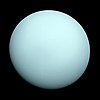Bianca (moon)
| Discovery | |
|---|---|
| Discovered by | Bradford A. Smith / Voyager 2 |
| Discovery date | January 23, 1986 |
| Orbital characteristics | |
Mean orbit radius | 59,165.550 ± 0.045 km[1] |
| Eccentricity | 0.00092 ± 0.000118[1] |
| 0.434578986 ± 0.000000022 d[1] | |
| Inclination | 0.19308 ± 0.054° (to Uranus' equator)[1] |
| Satellite of | Uranus |
| Physical characteristics | |
| Dimensions | 64 × 46 × 46 km[2] |
Mean radius | 27 ± 2 km[2] |
| ~8300 km²[3] | |
| Volume | ~71,000 km³[3] |
| Mass | ~9.2×1016 kg[3] |
Mean density | ~1.3 g/cm³ (assumed) |
| ~0.0086 m/s2[3] | |
| ~0.022 km/s[3] | |
| synchronous[2] | |
| zero[2] | |
| Albedo | 0.08 ± 0.01 [4] |
| Temperature | ~64 K[3] |

Bianca is a closer moon to Uranus. It was found from the images taken by Voyager 2 on 1986-01-23, and was given the designation S/1986 U 9.[5] It was named after the sister of Katherine in Shakespeare's play The Taming of the Shrew. It is also designated Uranus VIII.[6]
Bianca belongs to Portia Group of moons, which also includes Cressida, Desdemona, Juliet, Portia, Rosalind, Cupid, Belinda and Perdita.[4] These moons have similar orbits and photometric properties.[4] Other than its orbit,[1] radius of 27 km[2] and geometric albedo of 0.08[4] almost nothing is known about it.
At the Voyager 2 images Bianca appears as a stretched object, the major axis pointing towards Uranus. The ratio of axises of the Bianca's prolate spheroid is 0.7 ± 0.2.[2] Its surface is grey in color.[2]
References[change | change source]
- ↑ 1.0 1.1 1.2 1.3 1.4 Jacobson, R.A. (1998). "The Orbits of the Inner Uranian Satellites From Hubble Space Telescope and Voyager2 Observations". The Astronomical Journal. 115 (3): 1195–1199. Bibcode:1998AJ....115.1195J. doi:10.1086/300263. S2CID 118616209.
- ↑ 2.0 2.1 2.2 2.3 2.4 2.5 2.6 Karkoschka, Erich (2001). "Voyager's Eleventh Discovery of a Satellite of Uranus and Photometry and the First Size Measurements of Nine Satellites". Icarus. 151 (1): 69–77. Bibcode:2001Icar..151...69K. doi:10.1006/icar.2001.6597.
- ↑ 3.0 3.1 3.2 3.3 3.4 3.5 Calculated on the basis of other parameters
- ↑ 4.0 4.1 4.2 4.3 Karkoschka, Erich (2001). "Comprehensive Photometry of the Rings and 16 Satellites of Uranus with the Hubble Space Telescope". Icarus. 151 (1): 51–68. Bibcode:2001Icar..151...51K. doi:10.1006/icar.2001.6596.
- ↑ Smith, B. A. (January 27, 1986). "IAU Circular No. 4168". Retrieved 2006-08-06.
- ↑ "Planet and Satellite Names and Discoverers". Gazetteer of Planetary Nomenclature. USGS Astrogeology. July 21, 2006. Retrieved 2006-08-06.
Other websites[change | change source]
- Bianca Profile Archived 2007-08-01 at the Wayback Machine by NASA's Solar System Exploration

